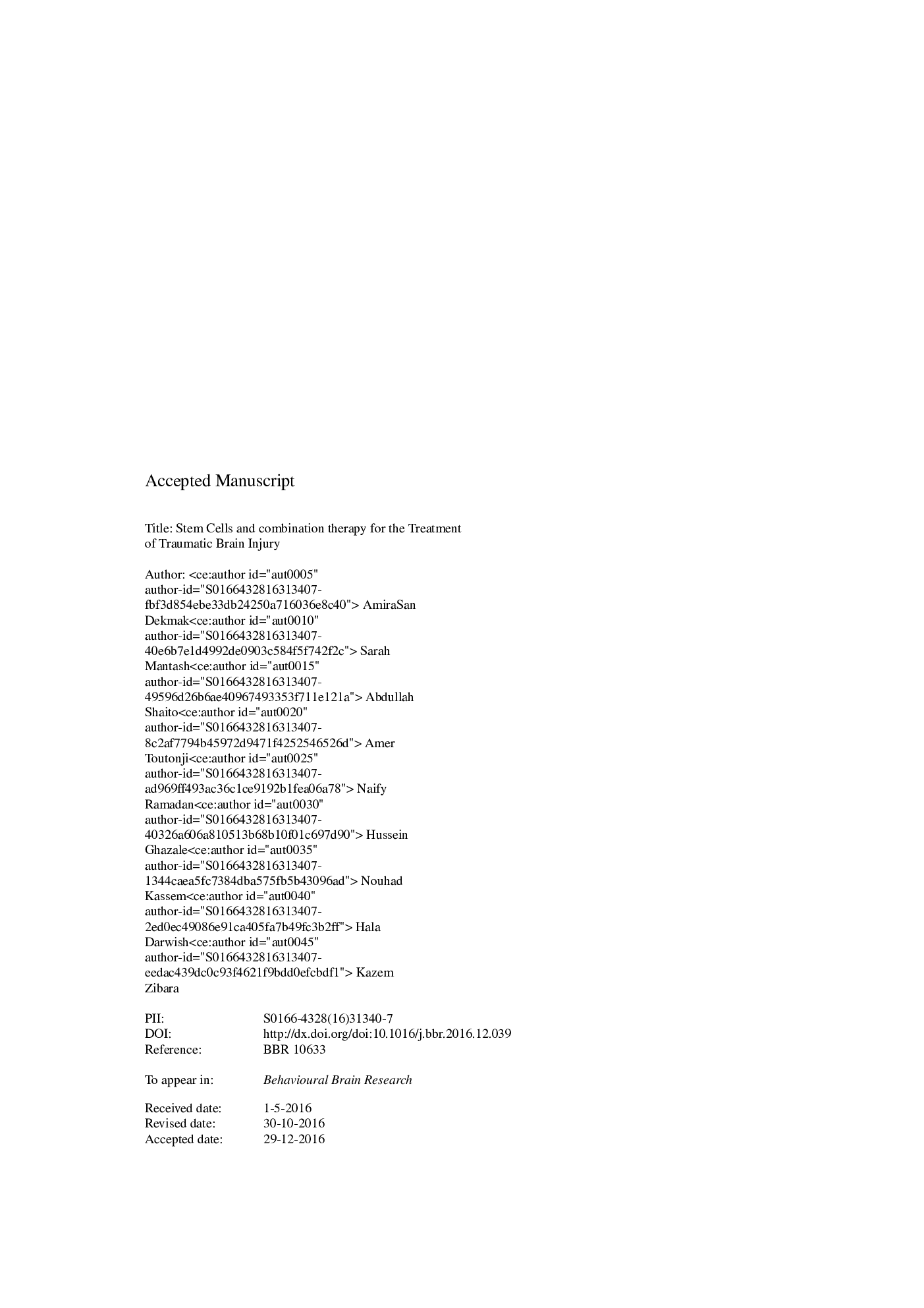| Article ID | Journal | Published Year | Pages | File Type |
|---|---|---|---|---|
| 8837934 | Behavioural Brain Research | 2018 | 43 Pages |
Abstract
TBI is a nondegenerative, noncongenital insult to the brain from an external mechanical force; for instance a violent blow in a car accident. It is a complex injury with a broad spectrum of symptoms and has become a major cause of death and disability in addition to being a burden on public health and societies worldwide. As such, finding a therapy for TBI has become a major health concern for many countries, which has led to the emergence of many monotherapies that have shown promising effects in animal models of TBI, but have not yet proven any significant efficacy in clinical trials. In this paper, we will review existing and novel TBI treatment options. We will first shed light on the complex pathophysiology and molecular mechanisms of this disorder, understanding of which is a necessity for launching any treatment option. We will then review most of the currently available treatments for TBI including the recent approaches in the field of stem cell therapy as an optimal solution to treat TBI. Therapy using endogenous stem cells will be reviewed, followed by therapies utilizing exogenous stem cells from embryonic, induced pluripotent, mesenchymal, and neural origin. Combination therapy is also discussed as an emergent novel approach to treat TBI. Two approaches are highlighted, an approach concerning growth factors and another using ROCK inhibitors. These approaches are highlighted with regard to their benefits in minimizing the outcomes of TBI. Finally, we focus on the consequent improvements in motor and cognitive functions after stem cell therapy. Overall, this review will cover existing treatment options and recent advancements in TBI therapy, with a focus on the potential application of these strategies as a solution to improve the functional outcomes of TBI.
Keywords
EGFRTNFαIL-6GFAPICPMSCsbFGFICAM-1TGFβRhoARBDIL-1βIL-10TNFR1CBFIGF-1NGFNMDAGDNFN-methyl-d-aspartatePTACCIAQP4IPSCsFGF2NSCsSVZHBOTEpha5GCsVNSP-selectinVCAM-1Y-27632GEFESCsAOCklf-4hEGFSox-2TBIFDAROCK inhibitorsHA-1077VDhPEG-SODAcquired Immuno Deficiency SyndromeOct-4BDNFCa2+DNAhESCNPCsROSAdenosine TriphosphateATPTraumatic brain injuryRetrograde amnesiaaquaporin 4Loss of consciousnessdeoxyribonucleic acidinsulin-like growth factor-1hyperbaric oxygen therapyAIDSInterleukin-10interleukin-6Transforming Growth Factor BetaVagal nerve stimulationtumour necrosis factor alphacerebral blood flowcluster of differentiationTreatmentCombination therapyCNSFood and Drug AdministrationBBBblood brain barrierHuman embryonic stem cellStem cellsMesenchymal stem cellsInduced pluripotent stem cellsEmbryonic stem cellsNeural stem cellsNeural progenitor cellscentral nervous systemdentate gyrusHuman epidermal growth factorfibroblast growth factor 2Ras homolog gene family member AGrowth factorsVascular endothelial growth factorVascular Endothelial Growth Factor (VEGF)nerve growth factorbasic fibroblast growth factorGlial cell line-derived neurotrophic factorBrain-derived neurotrophic factorintracranial pressureLocbone marrowsubventricular zoneIntercellular adhesion molecule 1Glasgow Coma ScoreHIVhuman immunodeficiency virusPathophysiologyPotassiumGlial fibrillary acidic proteinvascular cell adhesion protein 1CalciumReactive oxygen speciesEpidermal growth factor receptortumor necrosis factor receptor 1Rock
Related Topics
Life Sciences
Neuroscience
Behavioral Neuroscience
Authors
AmiraSan Dekmak, Sarah Mantash, Abdullah Shaito, Amer Toutonji, Naify Ramadan, Hussein Ghazale, Nouhad Kassem, Hala Darwish, Kazem Zibara,
